Hello there, this is Thersa Matsuura and you’re listening to Uncanny Japan. Here we are on the fourth and final installment of our Listeners’ True Spooky Tales. And it’s another outside-a-polooza. From next episode, we’ll be business as usual with something new I have up my sleeve. But today, we have more what the?! and eyebrow raising tales to hear.
Intro
Welcome back, okay are you ready to get into today’s stories? Yeah, me, too.
You’ll remember Cate. Her story about ghostly land and the oharai was the first one I read in our little series. I also told you she was really interesting and had cool experiences. I was right. Here’s another from her. It’s called On Pilgrimage.
Cate’s Spooky Tale: On Pilgrimage
I have undertaken the Saigoku Kannon Pilgrimage many times and I am the only foreigner designated as an official pilgrimage guide (sendatsu). These sacred places have been visited by pilgrims for over a thousand years and were probably established on sites that were sacred before that. When entering the precincts of many of these ancient sites, it feels as though you are quite literally stepping through a misty veil into a liminal space that is beyond here and now, yet somehow even more luminously real.
This sensation has been experienced by many fellow pilgrims who I have escorted on pilgrimage, foreigners who are not necessarily interested in Buddhism but are engaging in an interesting journey into the hinterlands of Japan, participating in a living ancient tradition. Yet within that liminal space pilgrims will always experience many emotions and sensations that they cannot explain and which will bring awe, wonderment, puzzled skepticism and sometimes very real fear of the unknown.
I want share however one particular day when I was on pilgrimage by myself and visited Ichijoji, a temple not far from Himeji city, in Hyogo prefecture. It was a warm day in September, yet as I walked up the long stairway towards the main temple, I felt a chill run through me that made me shiver.
After visiting the main temple, I proceeded on up the pathway to explore the mountain behind and take the pathway to the Oku-no-in, the innermost sacred precinct of the temple, first passing many ancient statues, their faces features blurred with time and covered in moss. The pathway gradually became narrower with wild vines and weeds crossing my path, and the temperature continued to drop as I entered further into the dense bamboo forest.
After some time, I came to an open space in the midst of the bamboo grove and there was small wayside shrine like you see everywhere in Japanese neighbourhoods and by the side of the road. Curiously, there was a clock hanging at the apex of the roof – an ordinary round, simple, plastic clock, the kind that might hang in any kitchen anywhere in the world.
The hands of the clock read two o’clock. I checked my own watch and was surprised to see that it was indeed exactly two o’clock. How strange, I thought, that someone comes all the way up here with fresh batteries to keep this clock on time.
Oddly, beside the little shrine was a modern statue of a young girl in a light dress, poised as if dancing, with a necklace of beads around her neck. It was unnaturally still, dark and quiet in the forest. No birds, no wind.
I continued on up the mountain, when suddenly, there lying across the pathway before me was a white snake, not moving, and I wondered if it was dead. But as I approached it raised up and turned its head towards me. I had never seen a white snake in Japan and I knew from my reading that white snakes are considered a sacred emanation of Kannon, so I was more curious than afraid. But the snake then slowly moved off into the thick bamboo grove.
At last I arrived at the Okunoin/奥の院, which at Ichijoji is named Sai no Kawara: it is a cave in the mountainside, with rocks and stones strewn all around and water trickling throughout. It is a clammy cold, dark and dank place, filled with a palpable sense of grief.
Sai no Kawara is the shore of the river that divides this world from Paradise. It is in this limbo that the spirits of dead children gather, and where they are forced by demons to build up piles of stones to make their own causeway to the other side. But every night an old hag demon comes along and knocks down the stones, so the children have to start all over again. But soon they are rescued by the compassionate Bodhisattva Jizo, who comes and gathers up the children in the folds of his robes and carries them across the river to the Pure Land on other side.
Here at Sai no Kawara I can see many cairns of small stones that have been placed here and there by grieving parents wanting to help the spirits of their lost children. There are also children’s toys and candy strewn among the wet rocks. At the top of the pathway, near the cave entrance, I see a solitary woman seated on a rock, silently weeping with her head in her hands and her long black hair covering her face and her shoulders, which are shaking with her sobbing. I feel very uncomfortable and wonder if my presence is imposing on her grief and consider turning and walking back down the mountain. But I too want to make an offering here and I have brought incense to light, so I slowly make my way up the slippery rocky path, stepping very carefully, so that I don’t slip on the mossy wet stones, and struggling to keep my balance, holding the rope strung along the path for support.
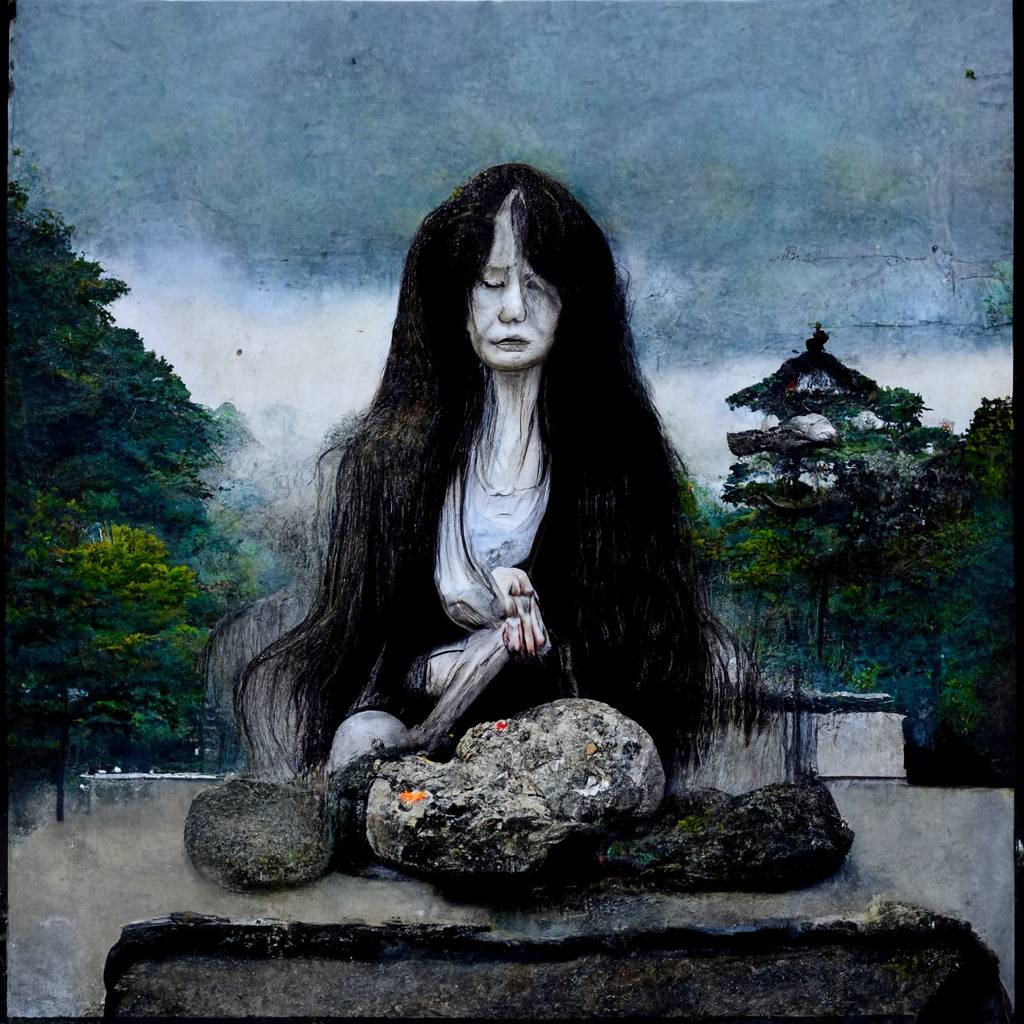
When I get to the entrance of the cave, I glance over at the woman… but there is no one there. I look all around and back down along the rocky path, but there is no one there. The rock where she was sitting is wet but there is no sign at all that anyone was there. There is only me in this haunting, haunted place of grief.
I felt quite bewildered and I had an odd sense of disorientation and dizziness, but I had come this far and I still wanted to make an offering so I lit incense and I recited the mantras to Jizo and to Kannon, and also made a little cairn of stones on this rock as a kind of bearing witness to the woman’s grief. I realised then that I was shaking with the intense cold and I really just wanted to get away from there.
I returned along the pathway back down the mountain, feeling with each step that I was returning to the comfort and surety of the mundane world. When I reached the clearing with the statue and the little shrine, I looked again at the clock, which still read exactly two o’clock. I checked my watch, but it was now twenty minutes to three. The clock was not ticking after all!
When I arrived back at the entrance gate to the temple grounds, the air was warm and balmy breeze was blowing, gently tinkling the little bells on a carousel hung with offerings of stuffed toys and pinwheels left by grieving parents for the spirits of their lost children. And I continued my pilgrimage along the road, walking perhaps a little more hastily than usual, away from this uncanny sacred place.
The end.
Wow, right? I’ll just let that one sit with you for a second.
My Brother-in-Law’s Spooky Tale: Something in the Water
Okay, lets continue down this path as it gets a bit darker and stops at a river here in Shizuoka somewhere. I’m not exactly sure where because this is a story my brother-in-law told me about years ago and it stuck with me. Very short, actually.
There was a spot in a river here where people would occasionally drown. There was nothing particularly dangerous about the spot. It wasn’t like there was a fast running current or anything. It was actually a little inlet with trees overhanging it. Very idyllic and calm. Although it was a little deep. It happened that the drowning happened often enough a sign was put up, not to swim there.
Cue one hot summer day when a group of boys decided they wanted to cool off in the river. They saw the sign, but didn’t really understand how basically a pool of standing water could cause someone to drown. So they jumped in and began swimming around. Horse playing, as boys tend to do. When one of them felt something touch his leg. Kind of grab on then let go. He thought it was one of his friends, but they were all splashing around him or on the shore accounted for. No one was under the water joking around. He got out of the water and told them what had happened. They thought he was joking, because the sign and all. It would have been a nice scary trick. But it wasn’t. One of the braver boys put on some goggles and swam down to the bottom of the little pool area to see what was there.
What did he find? There was some kind of round grate, like a sewer grate made up of heavy iron rods. Only it wasn’t securely settled. It looked as if it had been pushed partway off of whatever dark abyss lay below. He returned to his friends and they freaked out and never swam there again.
The end.
Now there is no way I can verify that. I don’t even remember what river he was talking about. But it makes for a good story and perhaps urban legend.
I’m not kidding when I say you’ll often come across signs near rivers with depictions of Kappa on them, warning people not to swim there or to be careful when the swim there. Remember kappa live in water and find it quite entertaining to pull swimmers and livestock, too, under the surface and drown them.
Phillip Jackson’s Spooky Tale: The Killing Beach
Next! Since we’re talking about water. Let’s go to the beach. I have recently learned about a fellow expat, originally from England, now living in Kyoto. His name is Phillip Jackson and he’s super nice and contacted me to share a book he’s written called Paranormal Kansai, which as it turns out is right up our alley. It’s literally a book about all sorts of ghostly and mysterious occurrences in the Kansai area along with the historical significance to each one.
I asked Phillip if there was a particular story that stood out to him and he chose the one I’m going to tell you about right now. It’s mostly Phillip’s research with a few details added that I found in that newspaper article I just mentioned. I agree with Phillip, it’s terrifying. And while not a personal experience, the nightmare happened in front of a lot of witnesses. You can even find a scan of a newspaper article written about it online. It also happens to be the deadliest water accident to occur in Japan to date.
It happened on Nakagawara Beach in Mie Prefecture, July 28th, 1955. This was exactly ten years after the war ended and students used to practice swimming in the ocean, not in a pool like they do now. That particular day was the last of a ten-day long swimming training session. It was their test day. The conditions were perfect. The weather was fine, no wind, waves were very light and the tides weren’t doing anything funny. Even the water the kids would be swimming in was only one meter deep. Deep enough to swim, but shallow enough to stand up if they needed to.
All together about 400 junior high school students, boys and girls and 19 teachers participated on this day. The test started at ten am when upward of 100 students entered the water. The accident occurred a few minutes later. It’s said almost immediately one teacher noticed a white line moving toward the shore from far out in the ocean. It looked almost like a small wave. But it disappeared before reaching the swimmers, so nothing was made of it. But that’s when suddenly those in the water started having problems staying above the surface. Dozens of young girls began calling and shouting out for help as they were swept under or pulled under the water. Teachers and the stronger swimmers went to help, but in the end, in an instant, 36 girls died that day. So many that there weren’t enough crematoriums in the area and they had to look to nearby cities to help.
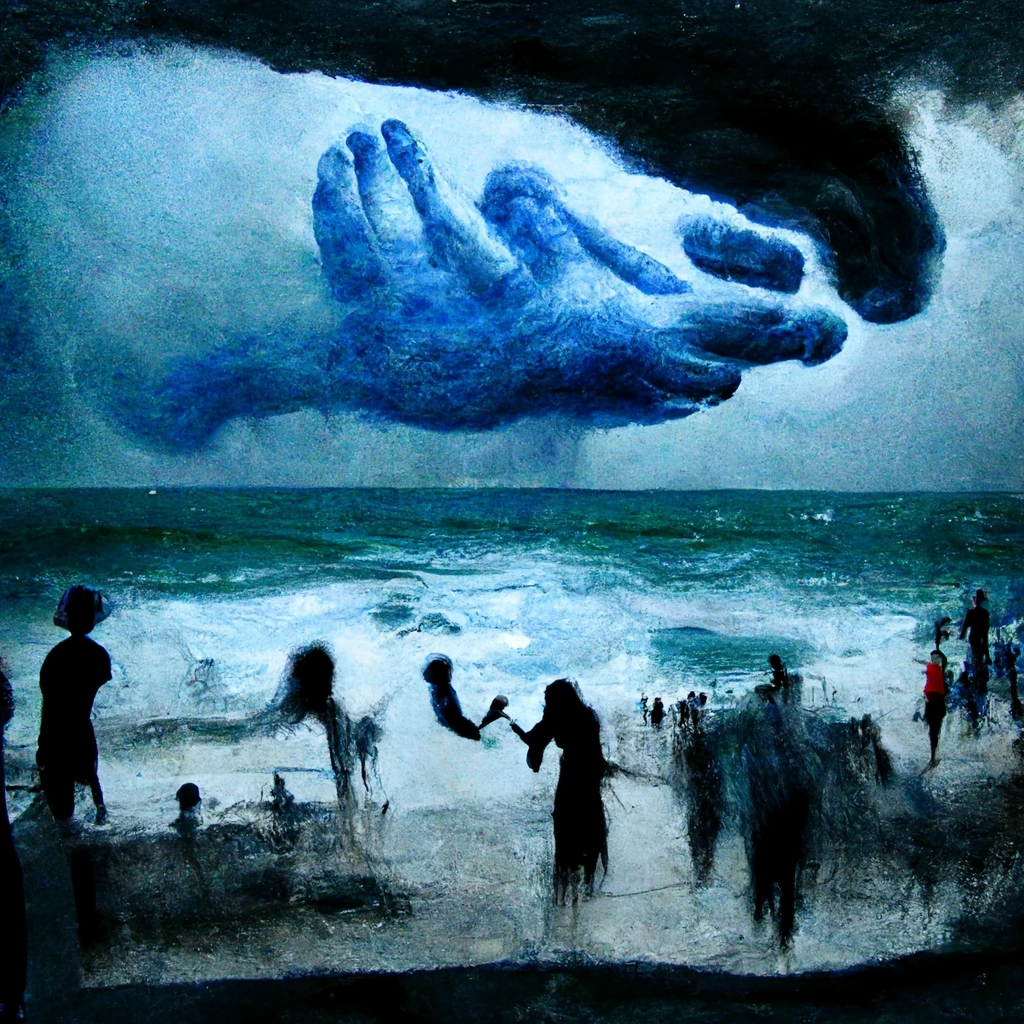
That’s not even the weirdest or scariest part of the story. It gets weirder. It’s said, that one of the terrified swimmers was holding a white bousai zukin when she was pulled ashore. A bousai zukin looks like and can be used as a cushion. But if there is an emergency, say an earthquake, you can open in and wear it as a thick padded hood that somewhat protects you head and shoulders from falling debris. Of course, these were very also used during the war when air raids were common. So why was this girl holding on to one? No one had brought theirs to the beach for a swimming test. Why would you? Later one of those who survived the incident said she saw a black clump moving toward the shore. The black clump was a group of women soaking wet, wearing bousai zukin.
They could find no reasonable explanation for the mass drowning. However, some time later students who had survived the event began to speak up. One of the survivors said that she had swam out to the designated area for the test, but while there her friend pointed to a line of people (the black clump) farther out in the sea all wearing the same bousai zukin and moving towards them. When these ghostly apparitions got close they disappeared under the surface. Very soon after, panic began when the swimmers felt hands grabbing their legs and pulling them forcefully under the water. Another survivor said she saw an expressionless white face before her before she was rescued. A different survivor said this in a magazine interview after she recovered from the shock of the experience. In Japanese: 海の底からたくさんの女の人がひっぱりに来た / From the depths of the ocean many female hands came to pull us under.
More and more of the students who had survived the episode began to come forward with similar stories. And if you that isn’t frightening enough, here comes the part where your skin really goes cold. As it turns out, during the war over thousands were killed in the city of Tsu, Mie during an American air raid conducted that ended on July 28th, the same date as this mass drowning, ten years prior. So many people had died and the crematorium had been destroyed that the bodies were taken to the ocean and buried there.
To this day that beach is a no swimming zone. I’ll put a link to Phillip’s book and the articles I read in the show notes.
Phillip Jackson’s Book: Paranormal Kansai
Online article in Japanese about the tragedy: Here.
Joanna’s Spooky Tale: A Blocked Path in the Woods
Wew. For our final story, I’ll lighten up a little bit. This sent in tale got me really excited. Our listener and Patron Joanna passed it along with permission from her friend, whom we’ll call S, for us to retell it here. I’m going to preface this with a mention of the nurikabe. I’m not sure how many of you are familiar with this funky Japanese youkai. I first learned about it from the anime Gegege no Kitaro and was like and have always been: what?! It’s basically a big wall (sometimes with a face, or just two wide set eyes, sometimes invisible). Whatever it looks like its MO is to suddenly appear in front of you when you’re walking at night. Its sole mission to impede your way or misdirect you. Some say it’s the trick of a tanuki and is called tanuki no Kabe, occasionally.
I just learned the reason Mizuki Shigeru included it in his GeGeGe no Kitaro world is because he actually encountered one in New Guinea. So there’s one real life meeting of this large youkai. Let me read you what Joanna wrote about her friend, S.
S was working as an English Language teacher in Japan in the 1990s (she worked for the same company as me and that’s how we first got to know each other). In the summer vacation she and a friend, another foreigner, went camping in the Japan Alps. I thought it was Gifu Prefecture but she can’t remember exactly where it was. She thinks she could find it on a map though (she majored in geography!) One evening the two of them went for a walk up a mountain track. When dusk began to fall they realised that they didn’t have torches with them and it would be difficult to navigate the path in the dark so they turned around and began to hurry back towards the campsite. Turning a corner, they slammed to a halt at the exact same time when they both saw what they thought was a huge boulder blocking the path. They edged forward trying to figure out how they were going to get back to their tent but there was nothing there. They managed to navigate the rest of the way safely but neither could explain what had happened on that mountain track.
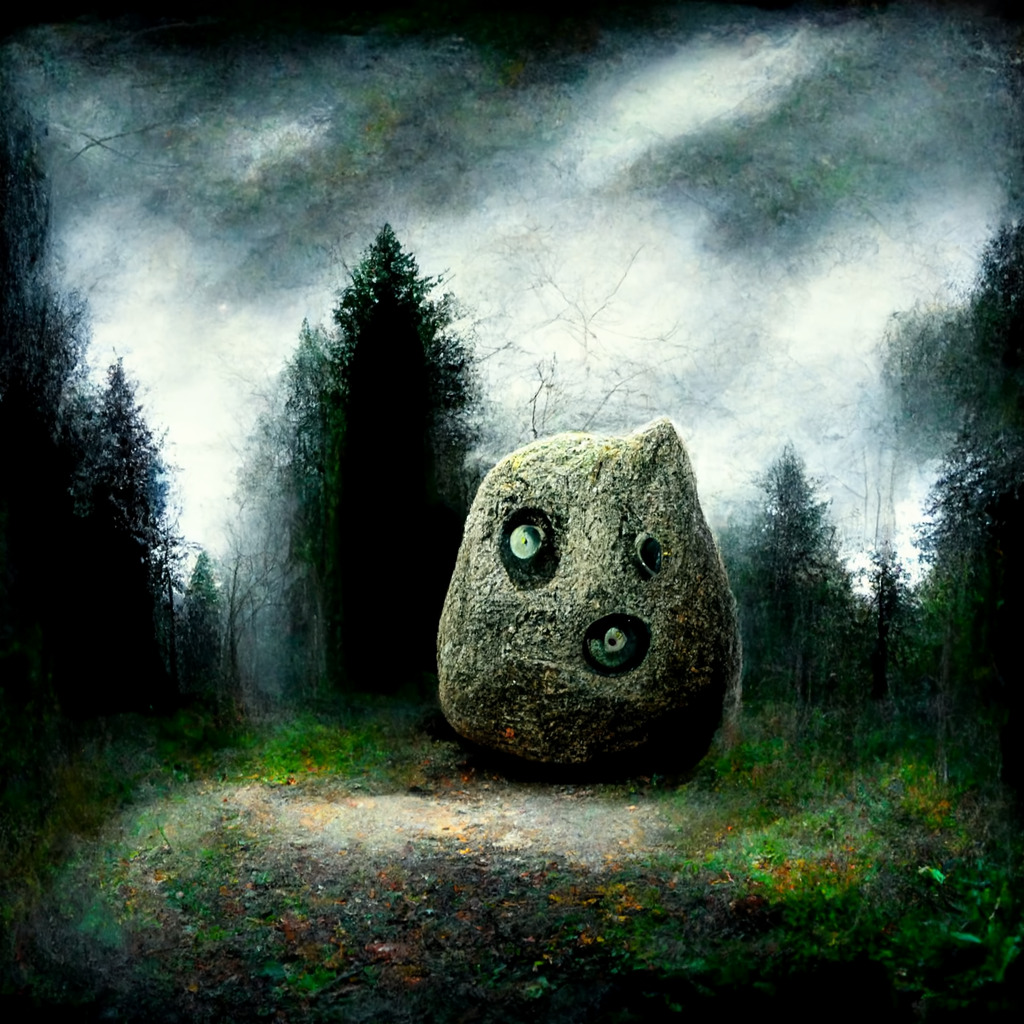
I find this story hugely intriguing. Someone in the British Isles might be primed to interpret (for example) a log floating in Loch Ness as a monster because of all the Nessie tales we hear growing up. But although it’s not impossible, it seems unlikely that S and her friend would have come across the nurikabe folktales – her friend was only visiting for a few weeks and had no prior knowledge of Japanese culture as far as I know. So it can’t have been that they were ‘seeing what they expected to see’. It’s especially weird that they both reacted to the phenomenon at the same time. Was it a trick of the light (or dark)? Or was it really something supernatural? It’s all very mysterious!
The end
I’m not sure why this story makes me so giddy, but it does. I want to hear more nurikabe tales, because it’s one of the few youkai I just can’t understand but get an absolute hoot out of.
So with that I will wrap up our Listeners’ True Ghostly Tales segment. We’ve made it to and have passed 100 episodes and now I’m aiming for the next hundred. I still have a long list and loads to talk about so otanoshimini shite kudasai. Thank everyone so much for writing in and sharing your experiences. It was a blast.
I’ll talk to you in two weeks!
Bye bye
Credits
Intro/outro music by Julyan Ray Matsuura
Creepy Piano Ambience by Tim Kulig
Link: https://filmmusic.io/song/8725-creepy-piano-ambience
License: https://filmmusic.io/standard-license

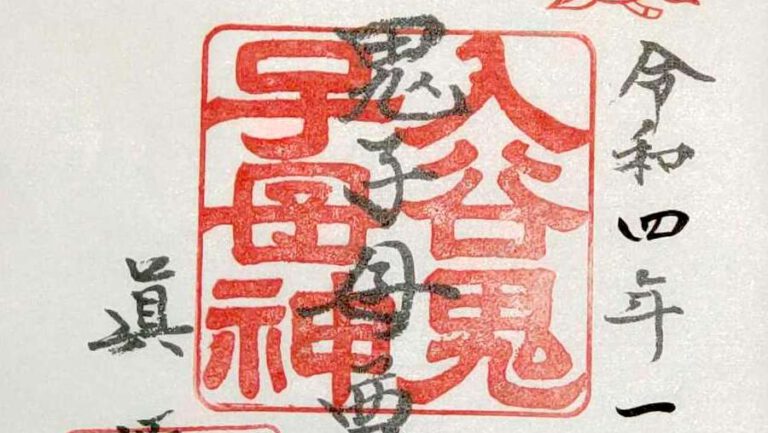
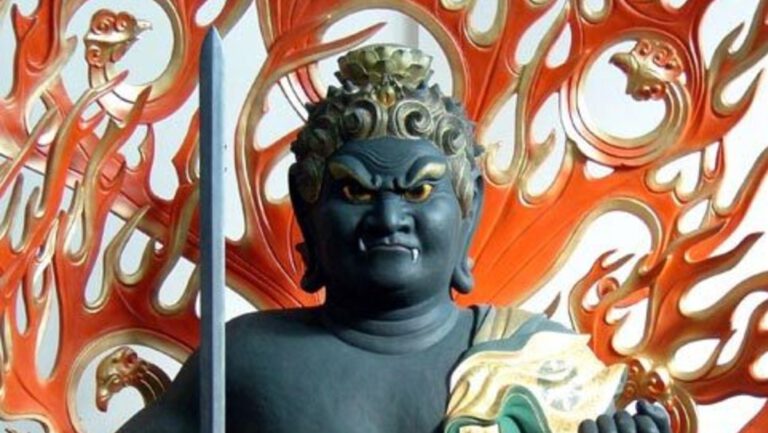
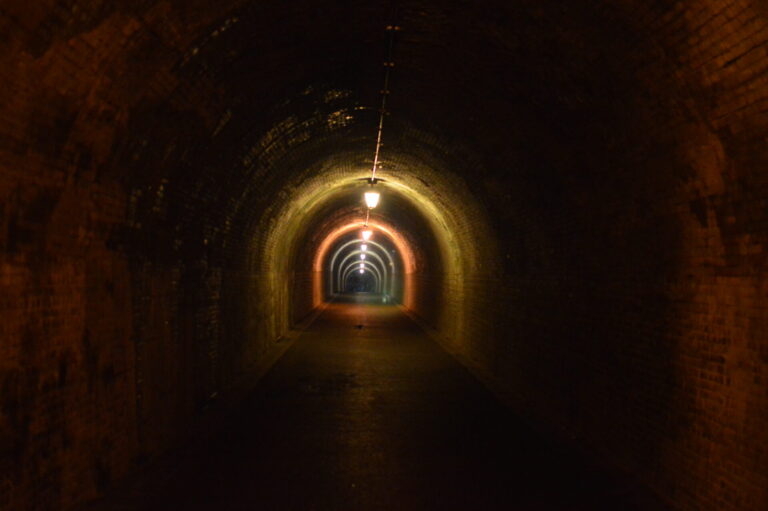
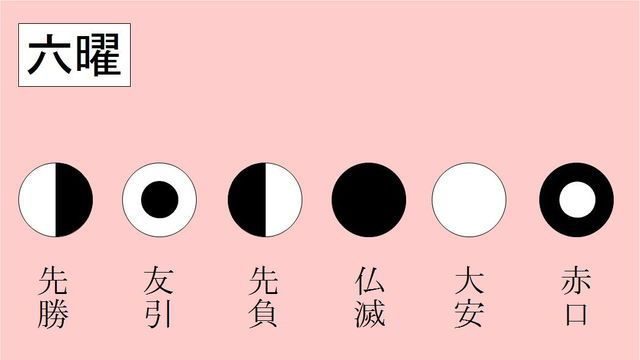


Hi Thersa. Thank you for including my friend’s story in this episode. I loved your retelling and the nurikabe artwork. The other tales were properly spooky this week, weren’t they? Especially the one about the swimming gala disaster – I’m still feeling a chill about that one.
Joanna, thank you so much for sharing her story. Nurikabe have always seemed like big benign goofballs to me. I’m glad that nothing bad happened and it was more of a What just happened?! kind of moment. The beach story was absolutely chilling. I agree.